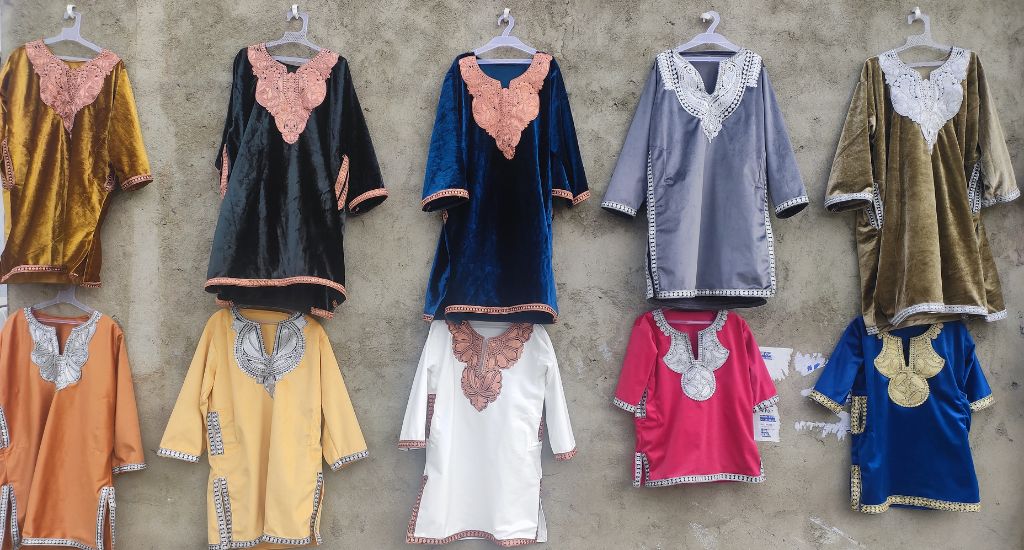
Kashmiri couture trends globally
Worn by Kashmiris of all ages and genders for centuries, the gown-like pheran is now trending globally, keeping local designers busy stitching up a storm.

Worn by Kashmiris of all ages and genders for centuries, the gown-like pheran is now trending globally, keeping local designers busy stitching up a storm.
Some wardrobes malfunction with the change of seasons, but Kashmiris know their gender-neutral “pheran” will stay with them through thick or thin, like it has for centuries—winter, summer, anytime.
Pheran? Yes. To the unpractised eye, it could pass off as an ill-fitting roomy robe. But if clothes reflect people’s cultural identity, heritage and way of life, the pheran asserts a place at the high table of Kashmiri tradition.
Not many know, but people have been celebrating World Pheran Day on December 21 since a proposal in 1931 was adopted by the Kashmir leadership of the time. The day marks the beginning of Chillai Kalan, the 40-day coldest period of winter.

Pherans made of heavy wool had been warding off Kashmir’s biting cold, while the flyweight cotton version stopped the Himalayan summer sun from burning the skin to a crisp.
It can be downright plain like the workman’s everyday pheran. Or, make a statement synonymous with luxury in silk awash with gilded embroidery. A piece of clothing for all ages similar to a kurta of the plains.
Also Read | Kashmir’s willow wickerwork gets a modern facelift
The traditional pheran, also spelt phiran, extends to the feet, which was popular up to the late 19th century, with pockets close to the waist but no side slits. The just-below-the-knees version is relatively recent and popular nowadays.
People have gone to the grave in a pheran.
The garment is now going places – winning its spurs on the beaches of California and the trendy streets of London.
In the summer of 2021, a blogger from the Kashmiri diaspora in the US gathered four friends and did a beach photo-shoot in pherans. It was an instant hit.

Ishtiyaq Qadir, a Kashmiri retailer in the UK, is pleasantly surprised by the number of pherans flying off his shop shelves lately.
“Only a handful of Kashmiris living here would buy pherans from us before. Sales picked up the past couple of years. I sell hundreds of them now,” the 45-year-old said over the phone, waiting for a shipment from Srinagar.
Also Read | Wakhoo: Journey from a sleepy village of timber traders to ‘Pencil Village’ of India
The pheran is trending among Kashmiri youngsters in a clear sign of the garment rebounding after wearing thin on the fashion scene in past decades.
Credit must go to designers constantly experimenting and stitching up cool styles to pull the pheran out of its downgraded status of a dowdy outfit for humble workmen and women at home.
There’s now a whole range: soft wool, tweed, cotton, linen, silk, satin, velvet, polyester, embroidered, jacquard, brocaded. The list is exhaustive.

No doubt, university student Sadiya Jan of Srinagar couldn’t make up her mind while browsing catalogues of e-tailers on her phone.
“My cousin’s getting engaged next week. There’s no way a tailor can stitch a pheran at such a short notice, given the winter rush. So, I decided to buy online,” she said.
Entrepreneur Mohammad Asif Malik, 30, from Srinagar has been making pherans for the past four years, initially catering to a local clientele. His customer base broadened after he posted his creations on Facebook.
“This winter has been particularly good because of orders from outside Kashmir,” he said.
Also Read | Kashmir’s cricket bats go global, give English willow a run for its money
Designer Shaista from south Kashmir’s Anantnag is harnessing the power of social media. She has thousands of Instagram followers. She makes and ships bespoke pherans for customers and successfully delivered many outside the Valley this season.
Women’s pherans are lavishly designed, but the men’s collection is mostly neutral and dark. Not anymore, said designer Masrat Subhan, who owns the Vien Rose boutique in Srinagar. Men can now go for body-fit outfits with checks and stripes, and optional zip collars and big buttons.
Some scholars suggest that the pheran was introduced by Mughal emperor Akbar after he took over Kashmir in 1586. But details of its origin are imprecise.

Chinese traveler Hiuen Tsang noted during his visit to the Indian subcontinent in the 6th century that Kashmiris wear a dress similar to that of the Persians, who called their shirt “perahan”. The Tajik word “peraband” is close too.
As a winter garment, many Kashmiris wear a surplice-like gown made of cotton or any lighter material below the woollen pheran for better insulation. Plus, the inner gown protects the wearer from scalding the abdomen while carrying a charcoal-fired portable fire pot, called Kangri, under the pheran.
Also Read | Kangri, the secret to Kashmiri warmth, and the risk around it
A portion of the credit for its growing popularity goes to politicians and celebrities who have been seen wearing pherans. Hindi cinema, too, serenades the pheran – Kashmir Ki Kali (1964), Jab Jab Phool Khile (1965), Roja (1992), to name a few classics.
Bollywood is blamed for typecasting the Kashmiri in a pheran, but tinseltown atoned for its failings with this ode from Bemisal in 1982: Kitni khoobsurat yeh tasveer hai. Yeh Kashmir hai, yeh Kashmir hai (How beautiful is this image? This is Kashmir, this is Kashmir)”.
The lead image at the top shows showcasing a variety of pheran for women in downtown Srinagar (Photo by Nasir Yousufi)
Nasir Yousufi is a journalist based at Srinagar.